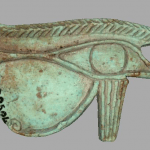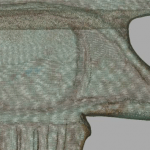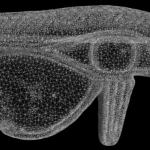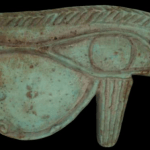The journey of a 3D model into interactive applications.
By Giancarlo Amati, on 2 February 2014
Photogrammetry and laser scanning are 3D imaging technologies that can generate very accurate 3D models of real objects. These techniques represent the object in the form of a very dense point-cloud dataset that can be several megabytes big. In order to use a 3D model in interactive applications, the point-cloud dataset has to be processed and transformed into another model which is smaller in file-size but with the same aesthetic features of the original one.
One of the problems of the point-cloud occurs when you try to zoom-in on the object and this will let you see the gap between points and loose the definition of details on the details.
A first step requires to represent the model with triangles instead of a million points (see images below); this process is called Meshing or Wrapping. Meshing a point-cloud can take several minutes depending on the mesh resolution (number of triangles) and on the size of original dataset.
A high-poly triangle mesh can contain millions of triangles; it gives an accurate representation of the geometry of the object, but it is still unsuitable for interactive applications. The mesh enters then another stage called Decimation (or Mesh Decimation) (see images above, center). Mesh decimation is a technique that computes a lower number of triangles without affecting the overall shape. The resulting mesh will be less dense, with bigger triangles for flat areas of the surface, and smaller and denser triangles for areas with fine details.
We are just one step away from our journey in the 3D mesh processing. One last step is to map the texture from the high resolution model onto the new low-poly mesh. (see figure above (right) with 65,000 triangles)).
At this point, it is possible to add some special effects to create more realistic renderings. In Computer Graphics (CG) there are several kinds of techniques to augment the realism of the visualization of low-poly models; one of those is called normal mapping (or bump-mapping). What does that do? All the fine features on the surface of a high-poly mesh can be lost in the mesh decimation resulting in a flat and uniformed coloured model. Normal mapping decodes all those finest features in the form of a 2D image which can be blended together with the texture of the low-poly model.
In the images on the right you can see the low-poly mesh without the normal mapping (left) and with a normal-map image (right). It is also possible to add more and more effects to create photo-realistic renderings. Some of these effects are called reflection-mapping (or environment mapping), light-mapping which contains the brightness of surface, ambient occlusion and many others. The model is now ready to be included in an interactive application for PC, for hand-held devices or in web-pages. An example of interactive application where you can find 3D models is “Tour of the Nile”, a free app available for iPAD. Download it from HERE.
Dr. Giancarlo Amati is Research Associate – Digital Developer at UCL, 3DPetrie Group, Petrie Museum of Egyptian Archaeology.
 Close
Close









